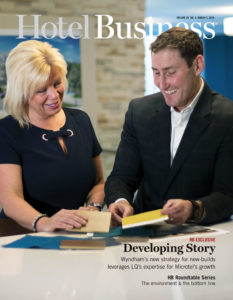NEW YORK—We’re all masters of our own personal brands. Discovering what sets us apart and leveraging that is part of making a name for ourselves, creating our own unique brand.
But what about hotels—should they be any different? A personal brand doesn’t stop with an individual, it extends to teams, and even properties. In today’s environment where every hotel offers similar amenities, dining outlets and in-room features, it’s all about discovering a hotel’s “edge,” and using that to create a winning—but also unique—campaign.
For Allen Adamson, co-founder/managing partner at Metaforce, a marketing consultancy based here, the majority of properties offer the same “what”: bigger TVs, better pools, fancier health clubs—but gone are the days of shiny new amenities for differentiation.
The focus now, Adamson said, is being able to define a brand’s services, the behaviors that create it and “how” hotels offer these, creating an experience that’s uniquely their own.
“You have to take the functionality—which will be the same wherever a guest stays—and build a service component around it. What kind of massages do you offer? How are guests greeted? What products does your spa use? What kind of yoga and Pilates do you specialize in? That service should enhance the experience and deliver the unique flavor that only your brand can give,” Adamson said.
He recognizes it’s much easier for hotels to upgrade amenities than to train an entire staff; it is, however, a worthy investment. Although a steep mountain to climb, Adamson urges hoteliers to think small; think like local mom-and-pop businesses and cater to specific guests when trying to differentiate—a common concern with big brand chains.
“Think small. Thinking big won’t help you create a unique experience. Think like a local entrepreneur and build off of what makes life in your property, on your block, in your neighborhood, different, and be authentic about it. Consumers have an uncanny ability to sniff out anything inauthentic. Create something that is ownable to you and you alone,” he said.
This extends far beyond picturesque property photos; it’s about creating a campaign that speaks to experience, not offerings.
“In today’s marketplace, word-of-mouth is the most important, most valuable driver for effective brand marketing,” Adamson said. “The theory is simple: Consumers will share extraordinary experiences. The execution is hard: Training staff, getting in touch with just what consumers need and then exceeding those needs is much harder.”
One of the market segments to most frequently thrive on experiences are millennials and Gen Z travelers, groups that consistently share online, letting an entire network of like-minded travelers know what’s good and what’s not.
“They’ve set the bar for offering experiences much higher,” Adamson said. “Their hunger for something worth sharing forces businesses and marketers to invest more in creating theater and magic when these consumers interact with their brand. Properties will have to do the same.”
Adamson recognizes millennials’ and Gen Z’s desire to discover and experience a trip that truly resonates with them. “They want to uncover something new that speaks to who they are and what they believe,” he said.
He suggested that marketers should consider the fact that bigger is not always better for these groups when crafting campaigns.
“Big, top-down marketing campaigns are less effective than enhancing the experience of your current customers,” Adamson said. “Your next millennial or Gen Z customer wants to feel as though they happened upon you organically and authentically through a customer review or a photo on Instagram. So, create an experience for your guests that will generate that content, and let them be your marketers. Create an environment that will be a catalyst for the sharing that plays right to their desires and habits, and send your word-of-mouth marketing through the roof. Build something your guests can do that their friends have yet to discover, and those friends are sure to discover you.”
Aside from younger guests, campaigns should also look to other groups, but properties should be mindful of too much differentiation, which can sometimes hurt rather than help branding campaigns. For travelers part of older generations, a lot of the expectations are the same, regardless of their specific reason for travel.
Adamson said there’s less and less of a separation between “business” and “leisure” travelers, noting that people can work anywhere, at any time. Because of this, hotels should focus on features associated with both business and leisure travelers and what both of these markets want, creating a more comprehensive branding campaign.
“Most guests are doing some work on vacation and some vacationing on business trips, so branding campaigns must reassure guests that they can mix and match work and play,” he said. “Breakfast options should depict both casual breakfast while you catch up on emails as well as white-tabled full breakfasts. Lobbies should also have places for work and pleasure.”
But campaigns, specifically, should reflect an overarching theme or message that resonates with guest needs, satisfying a multitude of groups.
“There is too much crossover to decipher what state of mind a given consumer might be in when they stay at your property, but this is still a world where focus in marketing is important,” Adamson said. “Rather than trying to slice and dice both your business and leisure offerings, create one look, one story, one experience that is authentic to your brand and caters to the multidimensional needs of your guests.” HB

